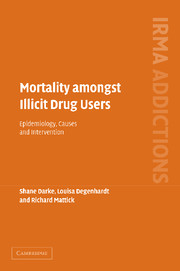Book contents
- Frontmatter
- Contents
- Acknowledgements
- List of tables
- Chapter 1 Why illicit drug-related deaths matter
- Chapter 2 The global epidemiology of illicit drug use
- Chapter 3 Mortality amongst illicit drug users
- Chapter 4 Mortality and drug overdose
- Chapter 5 Illicit drug use and disease
- Chapter 6 Mortality and suicide
- Chapter 7 Mortality and trauma
- Chapter 8 Reducing drug-related mortality
- Chapter 9 Summary and conclusions
- References
- Index
Chapter 5 - Illicit drug use and disease
Published online by Cambridge University Press: 30 September 2009
- Frontmatter
- Contents
- Acknowledgements
- List of tables
- Chapter 1 Why illicit drug-related deaths matter
- Chapter 2 The global epidemiology of illicit drug use
- Chapter 3 Mortality amongst illicit drug users
- Chapter 4 Mortality and drug overdose
- Chapter 5 Illicit drug use and disease
- Chapter 6 Mortality and suicide
- Chapter 7 Mortality and trauma
- Chapter 8 Reducing drug-related mortality
- Chapter 9 Summary and conclusions
- References
- Index
Summary
Introduction
This chapter will examine the major diseases associated with illicit drug use, and their contribution to mortality. As noted in Chapter 3, there are specific disease risks that are associated with illicit drug use that increase its salience as a cause of premature death. The impact that disease makes upon illicit drug using populations is illustrated in Table 5.1. In many of the studies of illicit drug user deaths conducted since the 1980s (after the advent of the human immunodeficiency virus (HIV) pandemic) the majority of the cohort have died as a result of disease, mostly commonly acquired immunodeficiency syndrome (AIDS) (Bargagli et al., 2001; Goedert et al., 1995; Langendam et al., 2001; Maxwell et al., 2005; Rehm et al., 2005; Zaccarelli et al., 1994).
In terms of the major diseases, drug injectors are at particular risk of infection with HIV or hepatitis C virus (HCV) through the sharing of injection equipment, and through unprotected sexual activity (in the case of HIV). HIV is a major cause of mortality among injecting drug users (IDU), as can clearly be seen in the studies presented in Table 5.1. Deaths related to chronic HCV infection may also constitute an increasingly important cause of mortality among this group.
- Type
- Chapter
- Information
- Mortality amongst Illicit Drug UsersEpidemiology, Causes and Intervention, pp. 67 - 79Publisher: Cambridge University PressPrint publication year: 2006

